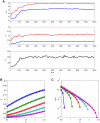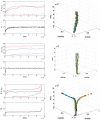Rapid transition towards the Division of Labor via evolution of developmental plasticity
- PMID: 20548941
- PMCID: PMC2883585
- DOI: 10.1371/journal.pcbi.1000805
Rapid transition towards the Division of Labor via evolution of developmental plasticity
Abstract
A crucial step in several major evolutionary transitions is the division of labor between components of the emerging higher-level evolutionary unit. Examples include the separation of germ and soma in simple multicellular organisms, appearance of multiple cell types and organs in more complex organisms, and emergence of casts in eusocial insects. How the division of labor was achieved in the face of selfishness of lower-level units is controversial. I present a simple mathematical model describing the evolutionary emergence of the division of labor via developmental plasticity starting with a colony of undifferentiated cells and ending with completely differentiated multicellular organisms. I explore how the plausibility and the dynamics of the division of labor depend on its fitness advantage, mutation rate, costs of developmental plasticity, and the colony size. The model shows that the transition to differentiated multicellularity, which has happened many times in the history of life, can be achieved relatively easily. My approach is expandable in a number of directions including the emergence of multiple cell types, complex organs, or casts of eusocial insects.
Conflict of interest statement
The author has declared that no competing interests exist.
Figures

 . Shown are at top: the average values of
. Shown are at top: the average values of  (red) and
(red) and  (blue), middle: the average fertility
(blue), middle: the average fertility  (red) and viability
(red) and viability  (blue), and bottom: the number of colonies
(blue), and bottom: the number of colonies  in the system. (B) The equilibrium values of
in the system. (B) The equilibrium values of  for different
for different  and
and  (blue),8, 16, 32 and 64 (pink).
(blue),8, 16, 32 and 64 (pink).  , so that
, so that  . (C) The relative equilibrium population size
. (C) The relative equilibrium population size  for the same values of parameters as in (b).
for the same values of parameters as in (b).
 . Second row:
. Second row:  . Third row:
. Third row:  .
.
 . For
. For  , and
, and  (lightly colored subcube), the major locus effects
(lightly colored subcube), the major locus effects  and
and  evolved very close to
evolved very close to  but the modifier effects
but the modifier effects  and
and  were around
were around  .
.
 and
and  values on the left of the corresponding curve. The dashed curve corresponds to no costs of gene supression (
values on the left of the corresponding curve. The dashed curve corresponds to no costs of gene supression ( ).
).Similar articles
-
Asymmetry, division of labour and the evolution of ageing in multicellular organisms.Philos Trans R Soc Lond B Biol Sci. 2021 Apr 26;376(1823):20190729. doi: 10.1098/rstb.2019.0729. Epub 2021 Mar 8. Philos Trans R Soc Lond B Biol Sci. 2021. PMID: 33678014 Free PMC article. Review.
-
Modeling functional specialization of a cell colony under different fecundity and viability rates and resource constraint.PLoS One. 2018 Aug 8;13(8):e0201446. doi: 10.1371/journal.pone.0201446. eCollection 2018. PLoS One. 2018. PMID: 30089142 Free PMC article.
-
A general allometric and life-history model for cellular differentiation in the transition to multicellularity.Am Nat. 2013 Mar;181(3):369-80. doi: 10.1086/669151. Epub 2013 Jan 28. Am Nat. 2013. PMID: 23448886
-
Multicellularity makes somatic differentiation evolutionarily stable.Proc Natl Acad Sci U S A. 2016 Jul 26;113(30):8362-7. doi: 10.1073/pnas.1608278113. Epub 2016 Jul 11. Proc Natl Acad Sci U S A. 2016. PMID: 27402737 Free PMC article.
-
Co-option during the evolution of multicellular and developmental complexity in the volvocine green algae.Curr Opin Genet Dev. 2016 Aug;39:107-115. doi: 10.1016/j.gde.2016.06.003. Epub 2016 Jul 2. Curr Opin Genet Dev. 2016. PMID: 27379901 Review.
Cited by
-
Evolution of irreversible somatic differentiation.Elife. 2021 Oct 13;10:e66711. doi: 10.7554/eLife.66711. Elife. 2021. PMID: 34643506 Free PMC article.
-
Adaptive evolutionary trajectories in complexity: Transitions between unicellularity and facultative differentiated multicellularity.Proc Natl Acad Sci U S A. 2025 Jan 28;122(4):e2411692122. doi: 10.1073/pnas.2411692122. Epub 2025 Jan 22. Proc Natl Acad Sci U S A. 2025. PMID: 39841150 Free PMC article.
-
Evolution of Reproductive Division of Labor - Lessons Learned From the Social Amoeba Dictyostelium discoideum During Its Multicellular Development.Front Cell Dev Biol. 2021 Mar 4;9:599525. doi: 10.3389/fcell.2021.599525. eCollection 2021. Front Cell Dev Biol. 2021. PMID: 33748102 Free PMC article.
-
Major evolutionary transitions in individuality.Proc Natl Acad Sci U S A. 2015 Aug 18;112(33):10112-9. doi: 10.1073/pnas.1421402112. Epub 2015 May 11. Proc Natl Acad Sci U S A. 2015. PMID: 25964342 Free PMC article.
-
Advantages of the division of labour for the long-term population dynamics of cyanobacteria at different latitudes.Proc Biol Sci. 2012 Sep 7;279(1742):3457-66. doi: 10.1098/rspb.2012.0755. Epub 2012 Jun 13. Proc Biol Sci. 2012. PMID: 22696525 Free PMC article.
References
-
- Buss LW. The Evolution of Individuality. Princeton: Princeton University Press; 1987.
-
- Maynard Smith J, Szathmary E. The Major Transitions in Evolution. Oxford: Oxford University Press; 1998.
-
- Grosberg RK, Strathmann RR. The evolution of multicellularity: A minor major transition? Ann Rev Ecol Syst. 2007;38:621–654.
-
- Bonner JT. Dividing the labor in cells and societies. Curr Sci. 1993;64:459–466.
Publication types
MeSH terms
Grants and funding
LinkOut - more resources
Full Text Sources
Other Literature Sources

